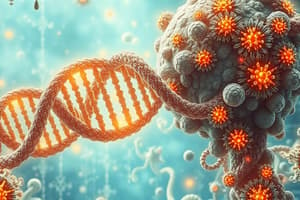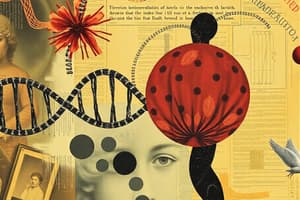Podcast
Questions and Answers
Which strand of DNA has the same sequence as the mRNA?
Which strand of DNA has the same sequence as the mRNA?
- Both A and B
- Coding strand (correct)
- Template strand
- No strand has the same sequence
What is the role of the A site in the ribosome during translation?
What is the role of the A site in the ribosome during translation?
- Selects the correct tRNA for the codon read (correct)
- Ejects empty tRNA
- Binds the mRNA transcript
- Holds the growing polypeptide chain
What occurs when a stop codon is reached during translation?
What occurs when a stop codon is reached during translation?
- Transcription is initiated
- Polypeptide chain is released (correct)
- A new mRNA strand is synthesized
- Ribosome continues translating
Which type of gene is always transcribed?
Which type of gene is always transcribed?
In the operon model, what is the function of the operator site?
In the operon model, what is the function of the operator site?
Which type of operon is activated in response to environmental changes?
Which type of operon is activated in response to environmental changes?
What triggers transcription activation in the lac operon?
What triggers transcription activation in the lac operon?
How does the ribosome behave after releasing the polypeptide chain?
How does the ribosome behave after releasing the polypeptide chain?
What happens to the trp operon in the absence of tryptophan?
What happens to the trp operon in the absence of tryptophan?
Which of the following best describes a repressible operon?
Which of the following best describes a repressible operon?
How do spontaneous mutations primarily occur?
How do spontaneous mutations primarily occur?
What was the outcome when HIV was subjected to increasing amounts of antiviral drugs in the laboratory?
What was the outcome when HIV was subjected to increasing amounts of antiviral drugs in the laboratory?
What is the typical frequency of replication errors that lead to spontaneous mutations?
What is the typical frequency of replication errors that lead to spontaneous mutations?
Which of the following statements is true regarding HIV and antiviral drugs?
Which of the following statements is true regarding HIV and antiviral drugs?
What is the primary effect of mutations on pathogens?
What is the primary effect of mutations on pathogens?
What causes chemical mutations in organisms?
What causes chemical mutations in organisms?
What is the role of the anticodon on tRNA?
What is the role of the anticodon on tRNA?
Which component of the ribosome catalyzes the formation of peptide bonds?
Which component of the ribosome catalyzes the formation of peptide bonds?
What happens during the initiation stage of transcription?
What happens during the initiation stage of transcription?
What is the reason for having 64 codon combinations for only 20 amino acids?
What is the reason for having 64 codon combinations for only 20 amino acids?
Which of the following statements about eukaryotic ribosomes is true?
Which of the following statements about eukaryotic ribosomes is true?
During transcription, which direction does RNA polymerase read the DNA?
During transcription, which direction does RNA polymerase read the DNA?
What initiates the termination of transcription?
What initiates the termination of transcription?
What distinguishes the coding strand from the template strand of DNA?
What distinguishes the coding strand from the template strand of DNA?
What is the primary function of ribosomal RNA (rRNA) in protein synthesis?
What is the primary function of ribosomal RNA (rRNA) in protein synthesis?
Which of the following correctly describes the Svedberg (S) values of prokaryotic ribosomes?
Which of the following correctly describes the Svedberg (S) values of prokaryotic ribosomes?
What does a nonsense mutation result in?
What does a nonsense mutation result in?
What is the primary purpose of plasmids in bacteria?
What is the primary purpose of plasmids in bacteria?
How does transduction occur in bacteria?
How does transduction occur in bacteria?
Which mutation type results in a different amino acid being incorporated?
Which mutation type results in a different amino acid being incorporated?
What happens during the process of conjugation?
What happens during the process of conjugation?
What is a common effect of a frameshift mutation?
What is a common effect of a frameshift mutation?
Which of the following describes transformation in bacteria?
Which of the following describes transformation in bacteria?
What might integrated viral genes (prophages) code for?
What might integrated viral genes (prophages) code for?
What characterizes a silent mutation?
What characterizes a silent mutation?
Which of the following is true regarding bacterial recombination?
Which of the following is true regarding bacterial recombination?
What is the role of DNA polymerase during DNA replication?
What is the role of DNA polymerase during DNA replication?
Which of the following describes the lagging strand during DNA replication?
Which of the following describes the lagging strand during DNA replication?
What is the purpose of transcription in microbial genetics?
What is the purpose of transcription in microbial genetics?
What differentiates RNA from DNA?
What differentiates RNA from DNA?
What is referred to as the triplet code in messenger RNA?
What is referred to as the triplet code in messenger RNA?
In DNA replication, what is meant by semiconservative replication?
In DNA replication, what is meant by semiconservative replication?
What role does RNA polymerase play in transcription?
What role does RNA polymerase play in transcription?
Which of the following correctly describes a codon?
Which of the following correctly describes a codon?
Which factors can affect gene regulation and expression?
Which factors can affect gene regulation and expression?
What is the function of ligase in DNA replication?
What is the function of ligase in DNA replication?
What is a key feature of the structure of DNA?
What is a key feature of the structure of DNA?
What type of genetic transfer occurs when DNA is taken up from the environment by a cell?
What type of genetic transfer occurs when DNA is taken up from the environment by a cell?
In terms of mutations, which of the following statements is TRUE?
In terms of mutations, which of the following statements is TRUE?
What are inducer molecules in gene regulation?
What are inducer molecules in gene regulation?
What is the function of tRNA in the protein synthesis process?
What is the function of tRNA in the protein synthesis process?
Study Notes
Microbial Genetics Overview
- Microbial genetics involves the study of genetic material in microorganisms, focusing on structure, function, gene replication, expression, and variation.
- Key terms include genome, transcription, translation, mutation, and more.
Structure and Function of Genetic Material
- DNA is a double-stranded helix made of nucleotides (A, T, G, C) with a deoxyribose sugar backbone.
- RNA consists of single-stranded nucleotides (A, U, G, C) with ribose sugar; it has distinct forms: mRNA, tRNA, and rRNA.
Transcription and Translation
- Transcription transfers genetic code from DNA to mRNA via RNA polymerase, creating mRNA as a complementary strand.
- mRNA contains codons (triplets of nucleotides) specifying amino acids for protein synthesis, with a specific reading frame essential for proper translation.
Translation Mechanism
- Translation occurs at ribosomes with three sites: A (aminoacyl), P (peptidyl), and E (exit) for tRNA binding.
- Stops codons in mRNA signal the end of polypeptide synthesis, leading to the release of the polypeptide chain.
Gene Regulation and Operons
- Genes can be constitutive (always transcribed), inducible (turned on by environmental factors), or repressible (turned off in certain conditions).
- Operons, clusters of related genes, are regulated as a unit; examples include the lac operon (inducible) and trp operon (repressible).
DNA Replication Process
- DNA replication is semiconservative, combining one old strand with one new strand.
- Leading strand grows towards the replication fork, while the lagging strand synthesizes short Okazaki fragments, later joined by DNA ligase.
Mutations
- Mutations are changes in nucleotide sequences, affecting phenotypes, and can arise from spontaneous errors, chemical mutagens, or radiation.
- Types include base substitution (silent, missense, nonsense mutations) and frameshift mutations (caused by insertions or deletions).
Genetic Transfer Mechanisms
- Plasmids are small, circular DNA molecules apart from chromosomal DNA, often carrying antibiotic resistance genes.
- Genetic recombination methods include conjugation (direct transfer via sex pilus), transformation (uptake of naked DNA), and transduction (transfer via bacteriophages).
Importance of Genetic Variation
- Bacterial genetic variation is crucial for adapting to environmental pressures, including antibiotic resistance, allowing populations to evolve rapidly under selective pressures.
Studying That Suits You
Use AI to generate personalized quizzes and flashcards to suit your learning preferences.
Related Documents
Description
Test your knowledge on microbial genetics, covering key concepts such as the structure and function of DNA and RNA, transcription, and translation processes. This quiz will assess your understanding of genetic material in microorganisms and the mechanisms of gene expression and replication.




